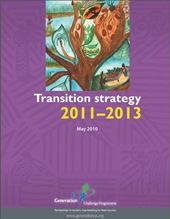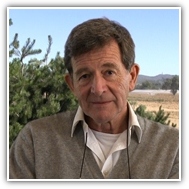GCP's sunset – Related blogposts
Related blogposts
Venture to GCP's blogosphere with the selected blogposts below that touch on GCP's sunset, or go directly to the dedicated GCP Sunset Blog.
|
GCP now, then, and after 
Where we've come from, where we are, and where we're going Dave Hoisington (pictured) is the Chair of GCP’s Consortium Committee, and currently ICRISAT’s Director of Research. Dave was previously with CIMMYT, GCP’s host Centre. He has therefore been involved with GCP "since day minus one" in his words. Travel with Dave from the beginning – and before the beginning – of GCP, and how the Programme will be brought to an orderly close. Dave also elaborates on the role of the Consortium Committee. |
Bird's eye view from the Board 
The GCP community, its labours and joys Please meet Andrew Bennett (pictured), the Chair of GCP’s Executive Board. Among other responsibilities, he is also President of the Tropical Agricultural Association, UK, chairs the SciDev.Net Board, and previously chaired the CIFOR Board. Andrew has worked on development programmes in Africa, Asia, Latin America, the Pacific and the Caribbean. In this post, Andrew shares his perspectives on GCP’s work, its impact, the challenges, the community GCP has built, and the role of the Board. |
|
On common ground – A longstanding association 
SDC and GCP In this post, we catch up with SDC’s Carmen Thönnissen (pictured). She walks us through the whys of Switzerland's continued funding to GCP that has spanned nearly the Programme’s entire lifetime. Carmen Thönnissen is Senior Advisor, Federal Department of Foreign Affairs, Swiss Agency for Development and Cooperation (SDC), Corporate Domain Global Cooperation of the Global Programme for Food Security. Through the years, SDC has been a consistent GCP funder. Here, Carmen gives us some insights into this longstanding relationship. |
GCP at its founding: What was the vision? 
A walk down memory lane with Masa We caught up with Masaru Iwanaga (pictured), previously Director General of CIMMYT in 2002–2008, and now President of the Japan International Research Center for Agricultural Sciences (JIRCAS), based in Tsukuba, Japan. CIMMYT is GCP's host Centre. Here's what Masa had to say about GCP's early years, and where the Programme is today... Read more... |
|
A chat with the Chief 
Inside GCP today Do a deep dive with Jean-Marcel into GCP’s 'engine room'. What makes the Programme work? How is it structured and governed? For a geographically dispersed Programme with multi-institutional teams, what's the trick that keeps the different parts moving and well-oiled to maintain forward motion minimise friction? Get acquainted (and hopefully 'infected') with the 'GCP Spirit'… Jean-Marcel Ribaut (pictured) is the GCP Director. His work involves coordinating the research activities and overseeing finances, ensuring that at the end of the day the overall Programme objectives are met... Read more... |
Generation next for plant breeding 
A shared vision What is GCP all about and why is its work important? Why was GCP created? Read recollections from key people involved in GCP’s conceptualisation, and how realisation of the shared vision continues today. Featuring candid conversations with Masa Iwanaga, former Director General, CIMMYT; Dave Hoisington, Consortium Committee Chair; Andrew Bennett, Executive Board member; and Jean-Marcel Ribaut, GCP Director. Read more... |
GCP's sunset – Taskforce
Taskforce
 The Taskforce was constituted in June 2012 as part of a transition plan approved by the Executive Board at its meeting in March that year, and later endorsed by the Consortium Committee in April. The Taskforce comprised of representatives of the Executive Board, the GCP Consortium Committee, the CGIAR Consortium Office, and reinforced with external consultants. The role of the Taskforce was primarily to guide identifying the various research and service products over the Programme's 10-year lifespan, and the possibilities for their post-GCP positioning to assure continued availability, sustainability and impact.
The Taskforce was constituted in June 2012 as part of a transition plan approved by the Executive Board at its meeting in March that year, and later endorsed by the Consortium Committee in April. The Taskforce comprised of representatives of the Executive Board, the GCP Consortium Committee, the CGIAR Consortium Office, and reinforced with external consultants. The role of the Taskforce was primarily to guide identifying the various research and service products over the Programme's 10-year lifespan, and the possibilities for their post-GCP positioning to assure continued availability, sustainability and impact.
Terms of reference
- Guide, review and approve the process of identifying the various outputs and products of GCP’s work that are pertinent to the transition process.
- Evaluate the Postion Papers to be prepared for the different GCP outputs and products, including assessing the post-GCP recommendations provided on each of the outputs and products by the GCP staff team and external advisors.
- Review institutional options and alternatives that may be suggested to accommodate GCP activities that are proposed to continue after GCP’s closure that may not fit into existing arrangements. This would include advice on appropriate external expertise that may be required to realise these options.
- Consider possible new and additional activities that could complement the 'homeless' activities mentioned above.
- If appropriate and necessary, and in co-ordination with the GCP Director, participate in approaches to, and consultations with, stakeholders, funders and partners.
- Keep the Executive Board and Consortium Committee informed, as appropriate, on deliberations and progress.
Members
|
Vivienne Anthony, Syngenta Foundation |
Andrew Bennett, GCP Executive Board (EB) Chair |
|
Stefania Grando, CGIAR Consoritum Office |
Dave Hoisington, GCP Consortium Committee Independent Chair/University of Georgia, USA |
|
Jurandir Magalhães, EMBRAPA |
John O’Toole, Consultant |
|
Markus Palenberg, EB member |
Jean-Marcel Ribaut, GCP Director |
GCP's sunset – Transition strategy
Transition strategy
Drafted in May 2010, the Transition strategy was submitted to the CGIAR Consortium Board in May 2010, in response to the CGIAR reform ongoing at the time, while also articulating how the Programme will be brought to an orderly close. The Transition strategy outlines the Programme’s raison d’être, explains the nature of GCP partnerships, and describes the organisation of the different activities in the GCP workplan until its closure. This activity portfolio is divided into a service component and 8 Research Theme components. While the research components aim to demonstrate – through selected use cases – that modern and integrated breeding approaches can have a significant impact on crop productivity in developing countries, the service component is conceived as a vehicle for dissemination of knowledge and technology, enabling broad access to and proactive distribution of crop genetic stocks and breeding material; molecular, genomics and informatics technology and information; cost-effective high-throughput laboratory services; and capacity building programmes. Download the GCP Transition strategy 2011–2013 (May 2010); also download the

![]() 2011–2013 GCP Medium-Term Plan (1 MB), which outlines GCP's workplan up to 2013, and complements the Transition Strategy.
2011–2013 GCP Medium-Term Plan (1 MB), which outlines GCP's workplan up to 2013, and complements the Transition Strategy.










